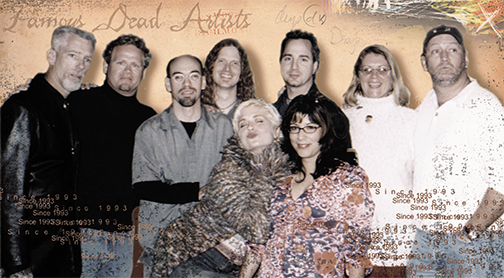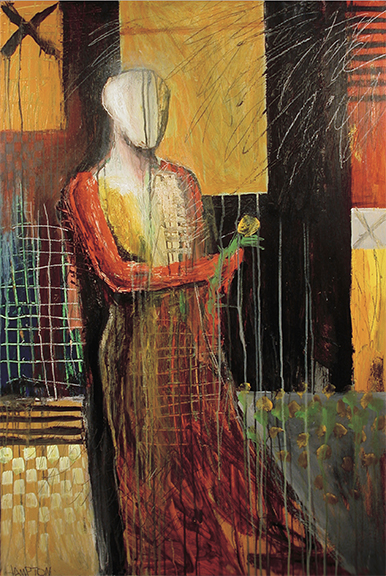
Tatted from nine disparate threads, the knotty collective called famous dead artists has enlivened Wichita’s art scene for a decade now.
The Famous Dead Artists coalesced in 1993 around a most utilitarian mission: to hang artworks on the bare walls of a retro-furniture gallery in Wichita’s Old Town.
“The owner wanted to make the space more inviting,” Wade Hampton fs ’91 recalls. “The space was huge.” It was going to take a lot of art to cover those walls. But Hampton and Scott Steele ’92, who had studied graphic design together at Wichita State, knew just the people to call.
So it was that most of today’s nine FDA members first exhibited together. “Our name…” Steele says, pausing to recall the genesis of the group’s name. He’s on the phone from Boise, Idaho, where he not only makes fine art — “wonderful cubisty, abstracty paintings” is one fan’s description —but also teaches graphic design and works as an award-winning designer. “I think,” he continues, “Marc, Wade and I were sitting in the kitchen of my Wichita apartment when ‘Famous Dead Artists’ came up. We were half joking, but the name just stuck.”
For whatever inexplicable reason, Wichita 10 years ago birthed a host of artistic personalities ripe to share their work with the wider community.
Akin in essence to Wichita’s earlier flowering of Beat artists (Bruce Conner fs ’55, David Haselwood fs ’53, Michael McClure fs ’53, to name a few), this new wave of artistic energy was propagated not only by FDA members but by a slew of individuals and other collectives, most notably the Fisch Haus.
“At that time in Wichita,” says Brian Hinkle ’92, an artist and assistant curator at the Wichita Center for the Arts, “there were few galleries and few opportunities for artists to show their work. Wichita was — and is — a pretty conservative city.
What FDA and the Fisch Haus accomplished was elevating the public interest in more raw, contemporary art. Those two groups are experts — like rock-n-roll bands — in building anticipation for their shows. They throw great parties. People go for the party and get a dose of culture despite themselves.”
Pam Terry, whose assemblages and mixed media dimensional work often reflect her explorations into Hispanic culture and what it feels like to be young, conflicted and female, says, “Being part of a group made it easier for us to get our work out there — to have our voices heard.”
Drawing from his knowledge of advertising, Steele adds: “There’s this buzz word, branding, that has to do with image-making and packaging. We happened to hit on a way of packaging ourselves that drew attention to our work. Lots of other Wichita artists were doing just as good, and better, art.”
Steele is too modest. Savvy promotional ploys may well have been the initial catalyst for the public’s intrigue with FDA, but can’t explain the cooperative’s longevity — or the individual successes of its diverse members. “Their power has proven to be more than the party thing,” Hinkle says. “The talent pools run deep in that group of artists.”
In 1994, the group acquired gallery space above the Big Sky Saloon on Douglas Avenue. Called the FDA Lounge, the space was more hang-out than typical gallery, its open and comfortable atmosphere serving Wichita’s art community as a touchstone of inclusiveness until its demise in 1999. During those years, FDA exhibited about twice a year as a group.
The collective’s most recent exhibition was “Create Or Die” this past October at Wichita’s Lee Shiney Gallery. Everyone was represented, even though some members had left Wichita years earlier to pursue career opportunities.
Brad Hart is doing that now; his destination, Las Cruces, N.M. Described as “quiet” and “solid” by fellow Dead Artists, Hart was an undergraduate at Arizona State at the same time Marc Bosworth was.
After graduating, the two came to WSU to study printmaking and earned master’s degrees in 1993 and 1992, respectively. Leigh Leighton-Wallace, who also holds a master’s degree in printmaking from WSU, says Hart’s work “is quiet, calm. His use of color is minimal and harmonious. His training as a printmaker and draughtsman shows in the sure hand used to make marks in the building of his imagery. Each touch of the tool is sure and thought through.”
Hart sees several similarities in his and Leighton-Wallace’s work. “Leigh and I are more realistic when compared to the others,” he says while taking a break from packing. “We also both use a lot of mythology in our work.” Hart often employs the myth of Adam and Eve in his explorations of male-female relationships. And his works almost always include a lizard, about which he says only, “Lizards are strong symbols. People either really like them or they don’t.”
While printmaking is one FDA connection to Wichita State, graphic design is another: Steele’s bachelor’s degree is in graphic design; Wade Hampton and Jennifer Wallace studied design at WSU; and Steele, Hampton and Bosworth all excel in the field. Bill Gardner ’59, a nationally recognized designer and owner of Gardner Design in Wichita, says he’s impressed with the way FDA’s working designers use fine art in their design: “They’ve worked hard to allow both to live — to not have to choose between the two gods of graphic design and fine art.”
The god of graphic design lost out when it came to Jennifer Wallace. “I took classes in graphic design,” she explains, “but in the end it just didn’t appeal to me.” Her sister, Leighton-Wallace, who lives in Shell Knob, Mo., and is an adjunct faculty member at Southwest Missouri State, says, “Jenni is, perhaps, the most direct artist of us all. Her work has a wired connection to her brain, particularly her emotions, and she quite literally lays it out on paper. Her imagery might be thought of as reading someone’s diary.”
Wallace says of her sister’s work: “Her art is fantastically, exquisitely well done. It always has a lot of intellect behind it.” In contrast to Leighton-Wallace’s alliterative and emotionally indirect work stands, for instance, Hampton’s.
With the help of artistic influences that include Karel Appel and Jean-Michel Basquiat, Hampton says he’s rebelled from his original mode of painting, photo-realistic portraiture: “I started realizing I could break the rules, and I started letting chaos in. I want to do art from the gut, without overthinking it. Everyone is born an artist. The trick is staying one.”
Hampton’s art — full of energy, distortions and unsettling color combinations — is being shown at the Horizon Gallery in Santa Fe. In Wichita, the Fire House Gallery featured more than 100 new works of his in the “Return of Art from the Gut: Art Show and Silent Auction” in June.
Armed with an artistic vocabulary conversant with those of Jasper Johns, Roy Lichtenstein and Robert Raushenberg, Bosworth — who one fellow Dead Artist describes as “a naturally happy person who fights with being unhappy” — often explores the theme of loss of innocence in his works, eight of which will be shown in August at the Delight Hamilton Gallery in Seattle. In addition to making art and working as a designer, Bosworth recently began teaching printmaking at Friends University in Wichita.
“Teaching has been inspirational for me,” he says. “When you see the students get excited about something you’re showing them — it’s just great.”
Chris Gulick first became enamored with art as a child spellbound by the beauty of St. Mary’s Cathedral in downtown Wichita. Today, he’s spellbound by Alexander Calder, Wassily Kandinsky, Joan Miró and Frank Lloyd Wright. Because he couldn’t draw as perfectly as his mom, he turned to kinetic sculpture and mosaics. His most consistently worked themes are cars, women and religion, specifically the concept of rebirth.
Curt Clonts, an unabashed promoter of Wichita and its artists, brought a new infusion of energy to FDA when he joined the group. A prolific artist, he describes his work as “naive grotesque.”
As night-and-day different as the nine FDA artists are, common threads do exist. Humor is one, Clonts says, and Leighton-Wallace adds, “We’re all compulsive — all of us are driven by something internal to create visual imagery.” From Gulick, though, comes the penultimate thought: “FDA is an entity unto itself — despite the individuals.”
Or rather, because of them.






